Enif, designated as Epsilon Pegasi, is the brightest star in the northern constellation of Pegasus, the celestial winged horse. It is a supergiant star, that can be seen with the naked eye.
Key Facts & Summary
- Enif is located at around 690 light-years / 211 parsecs away from our Solar System.
- Enif has an apparent magnitude of 2.399, and it is a type LC slow irregular variable star, having brightness variations from +0.7 to +3.5 in magnitude.
- The absolute magnitude of this star is -4.142.
- Enif is an orange supergiant star of spectral type K2 lp.
- This star’s spectrum shows an overabundance of the elements strontium and barium, which may be the result of the S-process of nucleosynthesis in its outer atmosphere.
- It has around 11.7 solar masses, and 185 solar radii, making it around 350 times bigger than our Sun.
- This star is 3,895 times brighter than our Sun, with its bolometric luminosity being 12,250 times greater.
- Enif is cooler than our Sun, with surface average temperatures reaching only 4,379 K.
- This star’s surface gravity has been measured at around 1.01 cgs.
- Enif has a rotational velocity of 20 km / 12.4 mi per second, while its radial velocity is 3.39 km / 2.1 mi per second.
- This star is quite young, much younger than our Sun, being only 20 million years old.
- Since Enif is so massive, it will most likely end its life in a supernova explosion.
- The best time to observe Enif, the other stars, and deep-sky objects located in the constellation of Pegasus, is during the month of October, when the constellation is the most prominent in the night sky.
- Pegasus was one of the first 48 Greek constellations, listed by the famous astronomer Ptolemy, in his 2nd-century star catalog, the Almagest.
- The constellation of Pegasus is now among the 88 modern constellations, where it holds the title of the 7th largest constellation in the sky, stretching for around 1,121 square degrees.
ε Pegasi
Epsilon Pegasi is known by its traditional name, Enif. The name Enif, is of Arabic origin, being derived from the word for “nose”. The star was named as such since its position in the constellation of Pegasus, the celestial winged horse, mark’s the muzzle of the horse.
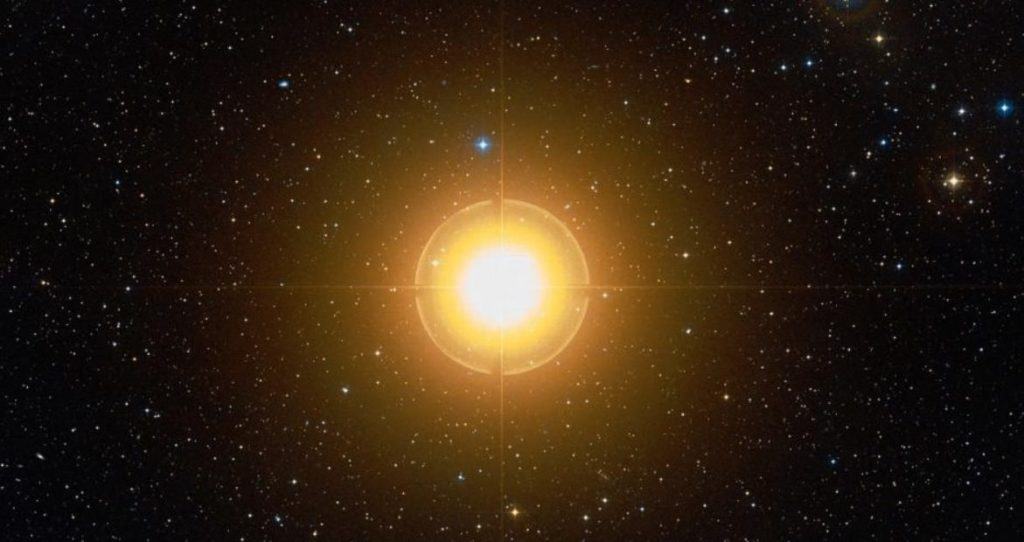
In late 2016, the WGSN approved the name Enif for the brightest star in Pegasus, Epsilon Pegasi. Epsilon Pegasi was known by other names, such as Fum al Faras – “the horse’s mouth”, or Al Jahfalah – “the lip” – the former name was also translated into Latin as Os Equi.
Formation
Enif / Epsilon Pegasi formed around 20 million years ago from a rich interstellar medium of gas and dust. Gravity pulled the swirling gas and dust together and gave birth to the brightest star in Pegasus, the supergiant Enif.
Enif is theorized to have formed from the same interstellar medium as the nearby yellow supergiants Sadalsuud / Beta Aquarii, and Sadalmelik / Alpha Aquarii, the brightest stars in the constellation of Aquarius.
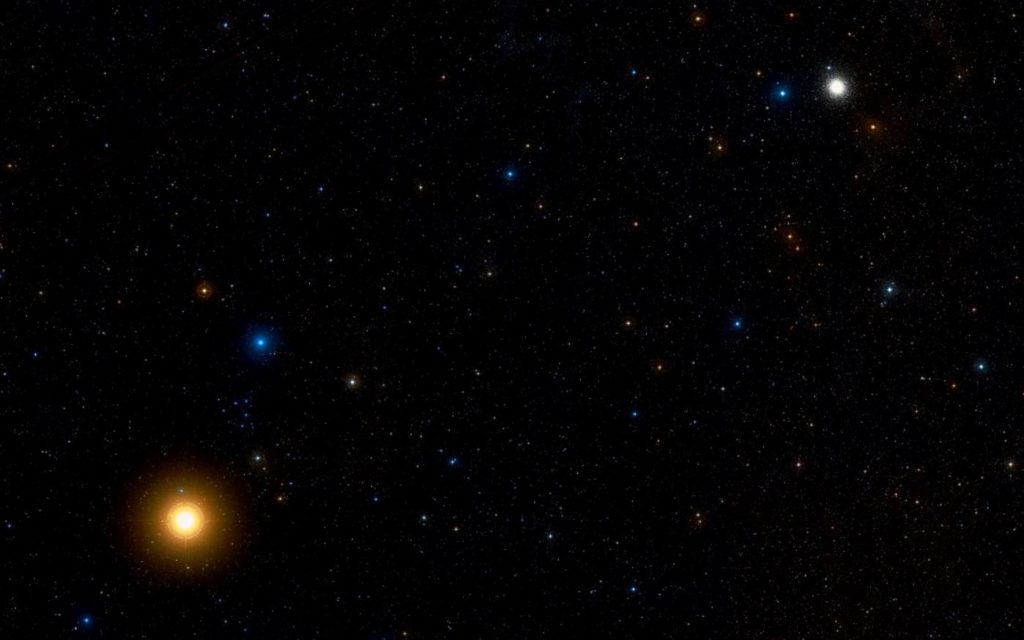
These three stars lie at similar distances and share a common motion through space, taking them perpendicular to the Galactic plane. Sadalsuud is a G-type supergiant located at 540 light-years away, while Sadalmelik is located at 520 light-years away.
Distance, Size, and Mass
Enif is located at around 690 light-years / 211 parsecs away from our Solar System. It is bright enough to be seen with the naked eye.
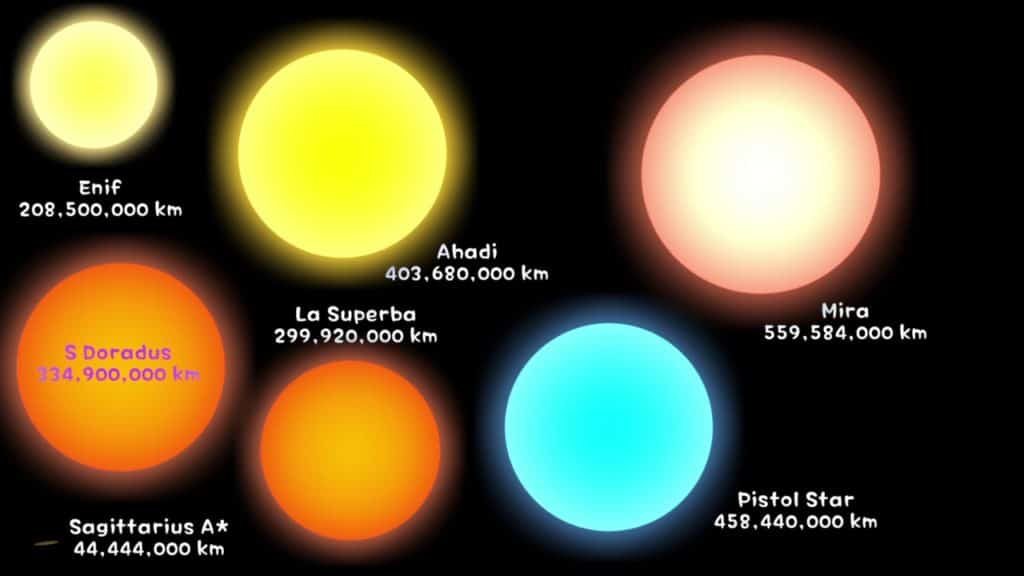
Enif has around 11.7 solar masses, or 1,170% of our Sun’s mass, and a whopping 185 solar radii, or 18,500% of our Sun’s radius. The star is thus 350 times bigger than our Sun. If Enif would replace our Sun, it’s photosphere would extend between the orbits of Venus and Earth.
Other Characteristics
Enif / Epsilon Pegasi is an orange supergiant star of spectral type K2 lp. This star’s spectrum shows an overabundance of the elements strontium and barium, which may be the result of the S-process of nucleosynthesis in its outer atmosphere.
It has an apparent magnitude of 2.399, and it is a type LC slow irregular variable star, having brightness variations from +0.7 to +3.5 in magnitude. The absolute magnitude of this star is -4.142.
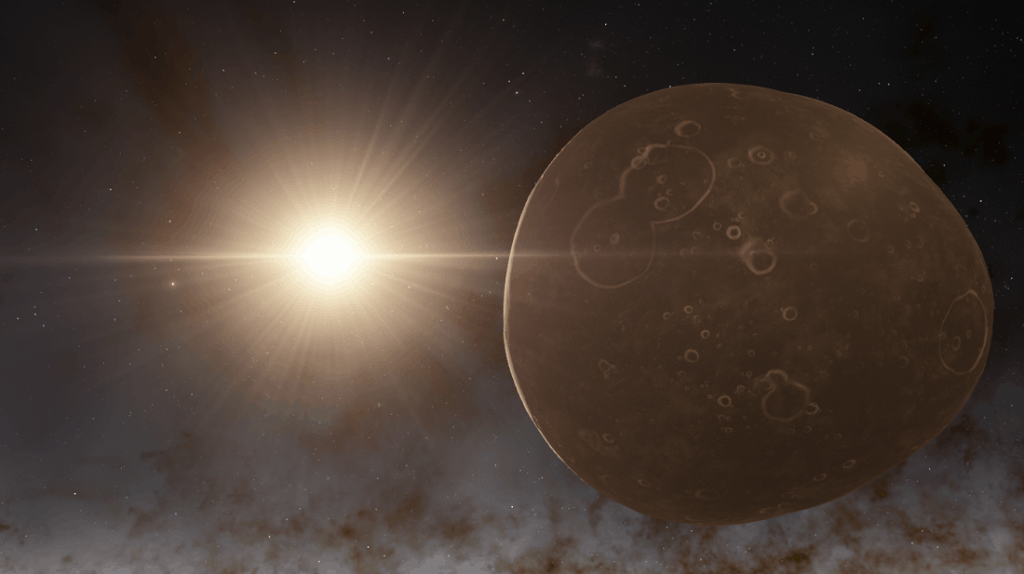
Enif is 3,895 times brighter than our Sun, with its bolometric luminosity being 12,250 times greater. Enif is cooler than our Sun, with surface average temperatures reaching only 4,379 K. This star’s surface gravity has been measured at around 1.01 cgs. Enif has a rotational velocity of 20 km / 12.4 mi per second, while its radial velocity is 3.39 km / 2.1 mi per second.
Location
Enif / Epsilon Pegasi is located in the constellation of Pegasus, the mythical winged horse. It is the brightest star in this constellation, with its position marking the muzzle of the celestial horse.
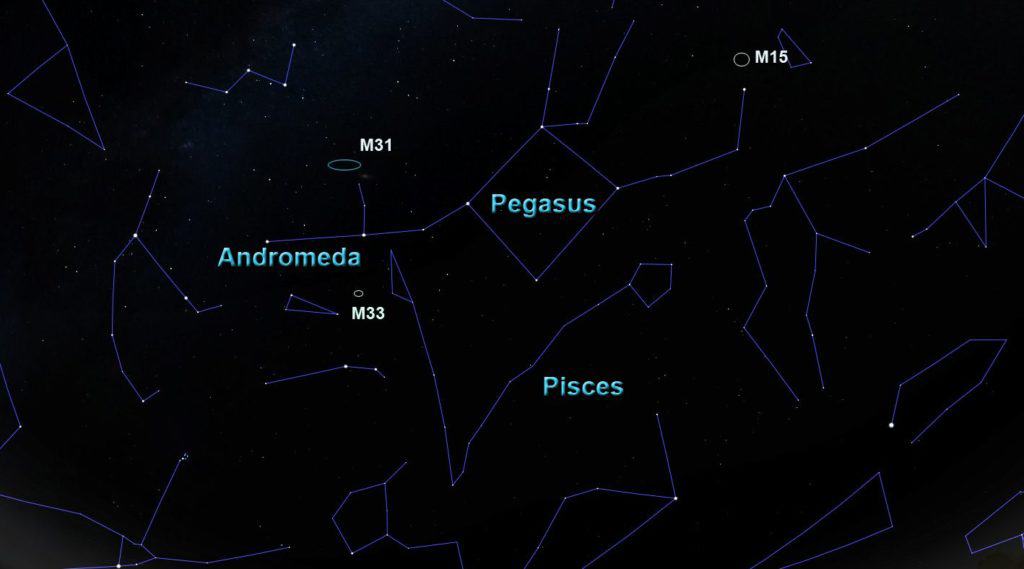
Enif is easy to find since it lies near the famous asterism, the Great Square of Pegasus, a conspicuous asterism that outlines the main body of Pegasus. The asterism is formed out of the three brightest stars in the constellation, namely Markab, Scheat, Algenib, and the star Alpheratz, which is the brightest star in the constellation of Andromeda.

The Great Square of Pegasus asterism is used by astronomers as a guide towards finding famous deep-sky objects, such as the Andromeda Galaxy.
Enif can be found between Markab, the star at the southwest corner of the asterism, and the constellation of Delphinus, which is easy to recognize due to its kite-shaped pattern.

One famous deep-sky object, namely Messier 15, which is also known as the Great Pegasus Cluster, is located near Pegasus, being 3o southeast of the bright star. This globular cluster is among the brightest of its kind, having an apparent magnitude of 6.2, and it is also among the densest, and oldest clusters in the Milky Way. It is 12 billion years old.
There are plenty of interesting bright stars in Pegasus, apart from the supergiant star Enif, which is the brightest star in Pegasus, there is the second-brightest star which is a red giant, Scheat, the third-brightest, Markab which is an A-type subgiant star, the fourth-brightest in Pegasus, Algenib which is a subgiant star, the red dwarf and white dwarf star system designated as AG Pegasi, the pulsating Phi, and Psi Pegasi red giants, the white star Salm, or the first discovered Sun-like star to host an exoplanet, 51 Pegasi, among many others.
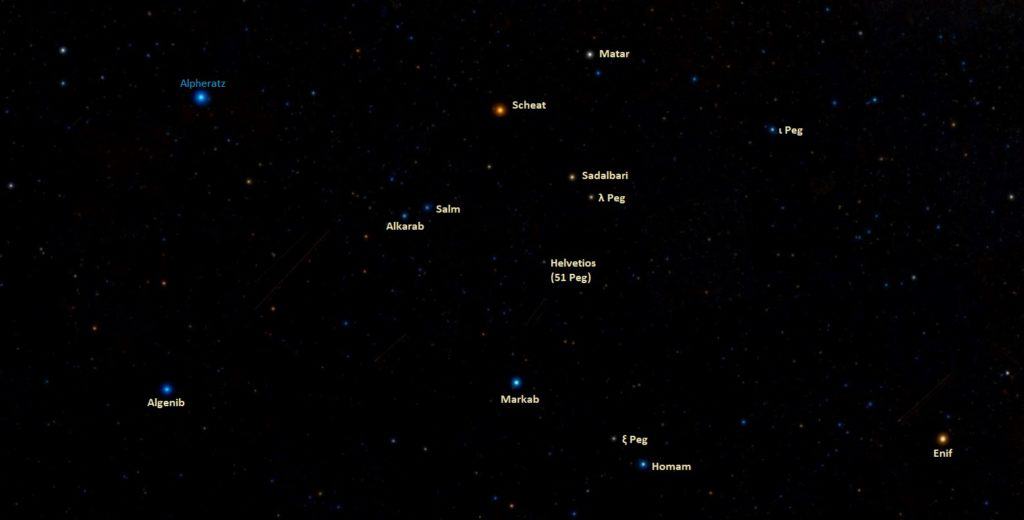
Currently, around 12 planets in Pegasus have been confirmed to host planets.
The constellation of Pegasus hosts numerous interesting deep-sky objects. Apart from the aforementioned Messier 15 globular cluster, some other deeps-sky objects that reside in the constellation of Pegasus are the spiral galaxy NGC 7331, the Seyfert galaxy NGC 7742, the quasar nicknamed as Einstein’s Cross, the Stephan’s Quintet – which is a cluster of galaxies, NGC 7725 and NGC 7753, which are a pair of colliding galaxies, the unbarred spiral galaxies NGC 7217, and NGC 742, the elliptical galaxy NGC 7315, or another pair of colliding galaxies, NGC 7318a and NGC 7318b, among many other objects.

The top ten brightest stars in the constellation of Pegasus are Enif – magnitude 2.399, Scheat / Beta Pegasi – magnitude 2.42, Markab / Alpha Pegasi – magnitude 2.48, Algenib / Gamma Pegasi – magnitude 2.84, Matar / Eta Pegasi – magnitude 2.95, Homam / Zeta Pegasi – magnitude 3.414, Sadalbari / Mu Pegasi – magnitude 3.514, Biham / Theta Pegasi – magnitude 3.52, Iota Pegasi – magnitude 3.77, and Lambda Pegasi, at magnitude 3.93.
The best time of the year to observe Enif, the other bright stars and deep-sky objects in the constellation of Pegasus, is during the month of October, when the constellation is the most prominent in the sky.
The Future
Though Enif is a very young star, being only 20 million years old (our Sun for comparison is 4.6 billion years old), it will end its life in a couple of million years.
Enif is massive enough to end its life in a supernova explosion, however, it may also end its life as a neon-oxygen white dwarf, due to its mass straddling the dividing line between stars destined to explode or not.
Did you know?
- Enif is among the 58 stars selected for celestial navigation, together with Markab / Alpha Pegasi. These stars are among the brightest and the most easily recognizable stars in the sky.
- Enif is known to erupt in solar flares. Such a flare was observed in 1972 when the star briefly appeared as bright as Altair, only to fade again in 10 minutes later. Theses superflares are very rare, and their mechanism is yet to be understood.
- The Chinese know Enif as Wei Su san – the Third Star of the Rooftop.
- The Wei Su – Rooftop, is a Chinese asterism composed out of Enif, Sadalmelik, and Biham. It is one of the seven mansions of the Black Tortoise.
Sources:
Image Sources:
- https://www.star-facts.com/wp-content/uploads/2020/04/Enif-1171×620.jpg?189db0&189db0
- https://www.star-facts.com/wp-content/uploads/2020/04/Enif-and-Messier-15.jpg?189db0&189db0
- https://i.ytimg.com/vi/z5AwBIElRYs/maxresdefault.jpg
- https://orionsarm.com/im_store/enif.png
- https://www.thoughtco.com/thmb/Qk8CAA3CVF43JefSCjga1fNiMzo=/1418×788/filters:no_upscale():max_bytes(150000):strip_icc()/pisces_andromeda_pegasus_constellations-5b8db1ea46e0fb0050ee1cad.jpg
- https://secureservercdn.net/160.153.137.14/z0h.e7b.myftpupload.com/wp-content/uploads/2018/10/pegasus_stars_1.jpg
- https://www.constellationsofwords.com/images/stars/Enif.JPG
- https://www.star-facts.com/wp-content/uploads/2020/04/Pegasus-stars.jpg?189db0&189db0
- https://s3.amazonaws.com/user-media.venngage.com/414579-0f799438bc77664420c7386a2ade8873.jpg
